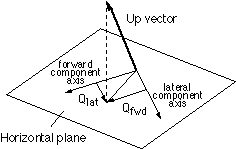 |
 |
 |
 |
 |
 |
 |
|

The RVs are two scalar components extracted from the given vector. The vector is sampled at the
|
 |
|
end of the current step, normalized, and projected onto the horizontal plane.
|
The projection is
|
 |
|
then decomposed into the two components as illustrated in Figure 3.13 for the up-vector case. for the up-vector case.
The components provide an indication of the forward and lateral lean of the chosen vector. The
forward direction is defined as being orthogonal to the ground-plane projection of a line joining
the biped's hips.
|
 |
|

|
 |
|
|
Figure 3.13 - Decomposition of up vector projection into RVs
|

Choice of Perturbation Parameters, [!]U
|
|
 |
|
|
|
 |
|
The balance control formulation of Figure 3.6 uses two linear parametric perturbations (LPPs) to
|
 |
|
control each step in the base PCG cycle.
|
Recall from Section 2.3 that each LPP consists of two
|
 |
|
basic components, a fixed PCG perturbation, and a scalar multiplier. New values for each scalar
multiplier are automatically computed for each step to balance that step. The fixed part of the PCG
perturbations remain the same throughout a given walk. This section discusses the choice of fixed
|
 |
|
PCG perturbations which must be supplied by the animator.
|
Throughout this section, the term
|
 |
|
"perturbation" will be used to refer strictly to the fixed part of an LPP rather than an arbitrarily
scaled perturbation.
|
 |

 1
2
3
4
5
6
7
8
9
10
11
12
13
14
15
16
17
18
19
20
21
22
23
24
25
26
27
28
29
30
31
32
33
34
35
36
37
38
39
40
41
42
43
44
45
46
47
48
49
50
51
52
53
54
55
56
57
58
59
60
61
62
63
64
65
66
67
68
69
70
71
72
73
74
75
76
77
78
79
80
81
82
83
84
85
86
87
88
89
90
91
92
93
94
95
96
97
98
99
100
101
102
103
104
105
106
107
108
109
110
111
112
113
114
115
116
117
118
119
120
121
122
123
124
125
126
127
128
129
130
131
132
133
134
135
1
2
3
4
5
6
7
8
9
10
11
12
13
14
15
16
17
18
19
20
21
22
23
24
25
26
27
28
29
30
31
32
33
34
35
36
37
38
39
40
41
42
43
44
45
46
47
48
49
50
51
52
53
54
55
56
57
58
59
60
61
62
63
64
65
66
67
68
69
70
71
72
73
74
75
76
77
78
79
80
81
82
83
84
85
86
87
88
89
90
91
92
93
94
95
96
97
98
99
100
101
102
103
104
105
106
107
108
109
110
111
112
113
114
115
116
117
118
119
120
121
122
123
124
125
126
127
128
129
130
131
132
133
134
135

